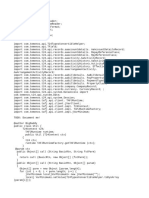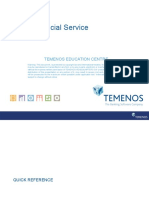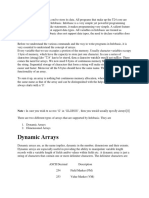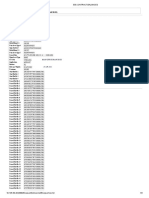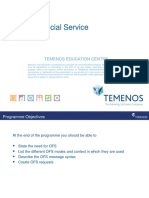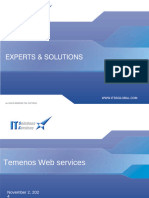Intro To Template Programming
Uploaded by
AkhtarIntro To Template Programming
Uploaded by
AkhtarTemplate Programming
TEMENOS EDUCATION CENTRE
Warning: This document, is protected by copyright law and international treaties. No part of this
document may be reproduced or transmitted in any form or by any means, electronic or mechanical,
for any purpose, without the express written permission of TEMENOS Holdings NV Unauthorized
reproduction or distribution of this presentation or any portion of it, may result in severe civil and
criminal penalties, and will be prosecuted to the maximum Copyright © 2004under
extent possible TEMENOS HOLDINGS
applicable law.” NV
Information in this document is subject to change without notice.
Copyright © 2005 TEMENOS HOLDINGS NV
Agenda
¾ What is a Template program?
¾ Why Template programming?
¾ Major components in a Template
¾ Types of Template
¾ Creation of a new application using the Template
T3DT – R05 – 1.0 Copyright © 2005 TEMENOS HOLDINGS NV
What is a Template Program?
APPLICATION PROGRAM
• Get data
• Stores data
T3DT – R05 – 1.0 Copyright © 2005 TEMENOS HOLDINGS NV
Why T24 uses Template Programming?
Any user who wishes to create a new application on T24 has to
make use of an existing program in T24 called a TEMPLATE in
order to
¾ Maintain code consistency and code standard
¾ Rapid code development
¾ Eliminate mundane tasks
T3DT – R05 – 1.0 Copyright © 2005 TEMENOS HOLDINGS NV
Major components
When creating a new application, there are various factors that
need to be kept in mind, like the
¾ Functions that can be allowed for the application
¾ Fields that comprise the application
¾ Field level validations
¾ Input level validations
¾ Authorization level validations
¾ Accounting entries that need to be generated for the transaction of the
application
¾ Limit checks
¾ Generation of delivery advices
¾ End of day processing
T3DT – R05 – 1.0 Copyright © 2005 TEMENOS HOLDINGS NV
Types of Template
Following are the different types of template programs available
¾ TEMPLATE
¾ TEMPLATE.L
¾ TEMPLATE.T
¾ TEMPLATE.W
T3DT – R05 – 1.0 Copyright © 2005 TEMENOS HOLDINGS NV
INSURANCE application an example
Using the INSURANCE application, a customer can deposit an
Insurance policy with the bank. There are different types of policies
that a customer can deposit. The INSURANCE application consists
of 2 main files.
¾ The INSURANCE file – Allows a customer to deposit a policy and
also allows the bank to charge a commission/charge
¾ The POLICY.TYPE file that holds details of the various policies
that a customer can deposit with the bank.
T3DT – R05 – 1.0 Copyright © 2005 TEMENOS HOLDINGS NV
Fields that comprise the main INSURANCE file
No Field Name Type Description Mandatory
1 POLICY.NO 16,A Standard T24 ID – Prefix IN Y
Should be a valid Policy Type in the POLICY.TYPE
2 POLICY.TYPE 35,A file.(See Below) Y
3 CUSTOMER.NO 10,CUS Must be a valid CUSTOMER Y
4 CURRENCY 3,CCY Must be a valid CURRENCY Y
5 COVER.AMOUNT 16,AMT Y
6 PREMIUM.AMOUNT 16,AMT Y
7 START.DATE 11,D Defaults to TODAY
Must be after START.DATE
8 PAYMENT.FRQ 16,FQO Must be after TODAY
9 XX<BENEFICIARY 10,CUS or 35,A Free Text
10 XX>ADDRESS 35,A Free Text
Only the following options are valid
OPTION1
OPTION2
OPTION3
OPTION4
Either the AGREEMENT.TYPE or CONDITIONS
11 AGREEMENT.TYPE 35,A must be set
12 CONDITIONS 35,A Free Text
13 XX.LOCAL.REF
T3DT – R05 – 1.0 Copyright © 2005 TEMENOS HOLDINGS NV
Fields that comprise the POLICY.TYPE application
No Field Name Type Description Mandatory
1 POLICY.TYPE.ID 7,A Y
2 XX.LL.DESCRIPTION 35,A Description of the policy type Y
Must be a valid CATEGORY
Must be in the product range 20000 -
3 CATEGORY 49999 Y
4 RESERVED12-1 NOINPUT
T3DT – R05 – 1.0 Copyright © 2005 TEMENOS HOLDINGS NV
Steps to create the INSURANCE Template
Step 1:
Make a copy of the TEMPLATE program that is available in the
GLOBUS.BP directory on to your local directory (Example TRG.BP).
Ensure that you save the TEMPLATE program with a different name
(Insurance – Name of the application that we are to create).
jsh…>COPY FROM GLOBUS.BP TO DEV.BP TEMPLATE
jsh…>sh
jsh…>cd DEV.BP
jsh…>mv TEMPLATE INSURANCE
jsh…>cd
jsh…>COPY FROM GLOBUS.BP TO DEV.BP TEMPLATE
jsh…>sh
jsh…>cd DEV.BP
jsh…>mv TEMPLATE POLICY.TYPE
T3DT – R05 – 1.0 Copyright © 2005 TEMENOS HOLDINGS NV
Steps to create the new INSURANCE Template
Step 2:
Change the name of the template program to your application name
(Insurance).
Change TEMPLATE to your
* SUBROUTINE TEMPLATE
Application name (Insurance)
******************************************************************
* Enter Program Description Here
*-------------------------------------------------------------------------
$INSERT I_COMMON
$INSERT I_EQUATE
T3DT – R05 – 1.0 Copyright © 2005 TEMENOS HOLDINGS NV
Steps to create the new INSURANCE Template
Step 3:
Basic template program is ready
Add relevant code in the appropriate paragraphs.
Add the various fields that the Insurance application needs to contain
T3DT – R05 – 1.0 Copyright © 2005 TEMENOS HOLDINGS NV
Steps to create the new INSURANCE Template
DEFINE.PARAMETERS:
To define the various fields that comprise an application.
Edit and add the necessary fields for our Insurance application.
*************************************************************************
DEFINE.PARAMETERS: * SEE 'I_RULES' FOR DESCRIPTIONS *
REM > CALL XX.FIELD.DEFINITIONS
RETURN
*************************************************************************
Remove the REM statement from the line CALL XX.FIELD.DEFINITIONS
and replace the XX to INSURANCE (application name)
CALL INSURANCE.FIELD.DEFINITIONS
T3DT – R05 – 1.0 Copyright © 2005 TEMENOS HOLDINGS NV
XX.FIELD.DEFINITIONS
SUBROUTINE XX.FIELD.DEFINITIONS
$INSERT I_COMMON
$INSERT I_EQUATE
$INSERT I_F.ACCOUNT ; * Other Inserts required for Check files, etc.
$INSERT I_F.CUSTOMER
*--------------------------------------------------------------------------
Paragraph to
GOSUB INITIALISE initialize variables
GOSUB DEFINE.FIELDS Paragraph to define
the fields of the
RETURN application
*--------------------------------------------------------------------------
T3DT – R05 – 1.0 Copyright © 2005 TEMENOS HOLDINGS NV
XX.FIELD.DEFINITIONS
DEFINE.FIELDS:
Actual field
definition
ID.F = "ID .NO" ; ID.N = "16" ; ID.T = "A"
Z=0
REM > Z+=1 ; F(Z) = "XX.XX.FIELD.NAME" ; N(Z) = "35.2" ; T(Z) = "A"
REM > Z+=1 ; F(Z) = "XX.XX.FIELD.NAME" ; N(Z) = "35.2" ; T(Z) = "A"
V=Z+9
RETURN
*-------------------------------------------------------------------------- V:Total number of fields in an
INITIALISE: application
Z:Number of fields defined
MAT F = "" ; MAT N = "" ; MAT T = "" V=Z+9 (To add 9 audit fields)
MAT CHECKFILE = "" ; MAT CONCATFILE = ""
ID.CHECKFILE = "" ; ID.CONCATFILE = ""
* Define often used check file variables
CHK.ACCOUNT = "ACCOUNT":FM:AC.SHORT.TITLE:FM:"L"
CHK.CUSTOMER = "CUSTOMER":FM:EB.CUS.SHORT.NAME:FM:'.A'
RETURN
---------------------------------------------------------------------------
END
T3DT – R05 – 1.0 Copyright © 2005 TEMENOS HOLDINGS NV
Steps to create the new Insurance Template
Step 4:
Copy the skeleton program XX.FIELD.DEFINITIONS from GLOBUS.BP to BP
with the name INSURANCE.FIELD.DEFINITIONS
jsh…>COPY FROM GLOBUS.BP TO DEV.BP XX.FIELD.DEFINITIONS
jsh…>sh
jsh…>cd DEV.BP
jsh…>mv XX.FIELD.DEFINITIONS INSURANCE.FIELD.DEFINITIONS
jsh…>cd
jsh…>COPY FROM GLOBUS.BP TO DEV.BP XX.FIELD.DEFINITIONS
jsh…>sh
jsh…>cd DEV.BP
jsh…>mv XX.FIELD.DEFINITIONS POLICY.TYPE.FIELD.DEFINITIONS
T3DT – R05 – 1.0 Copyright © 2005 TEMENOS HOLDINGS NV
Steps to create the new Insurance Template
Step 5:
INSURANCE.FIELD.DEFINITIONS is ready
Edit and add the necessary code
Specify the various attributes of a field
T3DT – R05 – 1.0 Copyright © 2005 TEMENOS HOLDINGS NV
Steps to create the new Insurance Template
Field Attributes:
¾ The maximum number of characters the field can hold.
¾ The minimum number of characters a field can hold
¾ The type of data the field can hold (Alphanumeric, Integer, Date
etc)
¾ Pick list for the field (if any)
¾ Other attributes of a field like whether it is a NOINPUT field or a
NOCHANGE, MULTIVALUE field, SUBVALUE field, etc.
T3DT – R05 – 1.0 Copyright © 2005 TEMENOS HOLDINGS NV
Attributes of the field
Attributes of a field have to be specified when a field is created. In order
to specify the attributes for a field, T24 gives us 3 arrays namely the
¾ F array
¾ N Array
¾ T Array
F Array:
To define the name of the field and to
specify if the field is a single value,
multi value or a sub value field. This
array also allows us to specify a field
as a language specific field.
T3DT – R05 – 1.0 Copyright © 2005 TEMENOS HOLDINGS NV
Attributes of the field
Attributes of a field have to be specified when a field is created. In order
to specify the attributes for a field, T24 gives us 3 arrays namely the
¾ F array
¾ N Array
¾ T Array
N Array:
To define the maximum and minimum
number of characters a field can hold.
This array is also used to set a flag to
specify whether any other validations
apart from the data type validation
have to be performed or not.
T3DT – R05 – 1.0 Copyright © 2005 TEMENOS HOLDINGS NV
Attributes of the field
Attributes of a field have to be specified when a field is created. In order
to specify the attributes for a field, T24 gives us 3 arrays namely the
¾ F array
¾ N Array
¾ T Array
T Array:
To define pick list for a field, if any.
Used to specify whether a field is a
NOINPUT field or a NOCHANGE field.
T3DT – R05 – 1.0 Copyright © 2005 TEMENOS HOLDINGS NV
Attributes of the fields
Following is the way to define a field using the 3 different arrays
F(1) = “Fieldname” ; N(1) = “35.1.C” ;T(1)<1> = “A”
These refer to the field numbers. For
definition of the 2nd field, they would
become ‘2’ and so on.
T3DT – R05 – 1.0 Copyright © 2005 TEMENOS HOLDINGS NV
F Array
F Array has been used to define the name of the Field.
Define a single value field in the following way
F(1) = “Fieldname”
Define a multi value field in the following way
F(1) = “XX.Fieldname”
Define a sub value field in the following way
F(1) = “XX.XX.Fieldname”
In order to define an associated multi value field the definitions has to be as
follows
F(1) = “XX.XX<Fieldname1”
F(2) = “XX.XX-FieldName2”
F(3) = “XX.XX>FieldName3”
T3DT – R05 – 1.0 Copyright © 2005 TEMENOS HOLDINGS NV
N Array
The N array comprises of 3 parts
• The first part is used to specify the maximum number of characters.
• The second part is used to specify the minimum number of characters.
• A value ‘C’ in the third part of this array is used to signify that extra
validation has to be done for this field.
Example : N(1) = “35.1.C”
T3DT – R05 – 1.0 Copyright © 2005 TEMENOS HOLDINGS NV
T Array
The T array consists of 3 elements.
Element 1 Element2 Element3
IN2 Routines Pick Lists NOINPUT/NOCHANGE
T3DT – R05 – 1.0 Copyright © 2005 TEMENOS HOLDINGS NV
T Array
Element 1:
The first element of the T array is used to define the type of data
the field has to contain.
Example : T(1)<1> = ‘A’
The value input for the 1st element refers to a suffix of an IN2
routine.
T3DT – R05 – 1.0 Copyright © 2005 TEMENOS HOLDINGS NV
IN2 Routines
There are a number of IN2 routines existing in T24. Using these IN2 routines
we can restrict the type of data that is entered into a field.
IN2 Routine Name Description
IN2AAA Characters from a-z and A-Z only
IN2 Numeric data
IN2D Will accept input in any of several valid date formats. The date input
will be expanded to the full date YYYYMMDD and displayed as DD
MMM YYYY.
IN2AMT This routine accepts input of an amount and can edit the input to have
the number of decimal places defined for a specified currency.
IN2CUS Input must be a valid customer number, i.e. 1 - 10 numeric. Input of a
customer mnemonic will also be accepted and converted to the
customer number.
T3DT – R05 – 1.0 Copyright © 2005 TEMENOS HOLDINGS NV
T Array
Element 2:
The second element of the T array is used to define pick lists for a
field.
Example : T(1)<2> = “Value1_Value2_Value3_Value4_Value5”
Incase the pick list for a field has to contain values of another field in another
Application, then a component called ‘CHECKFILE’ can be used.
F(1) = “Fieldname” ; N(1) = “35.1.C” ; T(1)<1> = “A”
CHECKFILE = “Filename” : FM : Fieldname : FM : “L”
Name of the file that has to be read(NO F Prefix)
Name of the field whose value has to be used as
enrichment
Return a language associated enrichment
T3DT – R05 – 1.0 Copyright © 2005 TEMENOS HOLDINGS NV
T Array
Element 3:
The third element of the T array is used to make a field a NOINPUT or an
NOCHANGE field.
Note : (Remember a field cannot be NOINPUT and NOCHANGE)
T(1)<3> = “NOINPUT” (or)
T(1)<3> = “NOCHANGE”
T3DT – R05 – 1.0 Copyright © 2005 TEMENOS HOLDINGS NV
POLICY.TYPE.FIELD.DEFINITIONS
SUBROUTINE POLICY.TYPE.FIELD.DEFINITIONS
$INSERT I_COMMON
$INSERT I_EQUATE
GOSUB INITIALISE
GOSUB DEFINE.FIELDS
RETURN
T3DT – R05 – 1.0 Copyright © 2005 TEMENOS HOLDINGS NV
POLICY.TYPE.FIELD.DEFINITIONS
DEFINE.FIELDS:
ID.F="POLICY.TYPE.ID";ID.N="7";ID.T=""
Z=0
Z+=1; F(Z)="XX.LL.DESCRIPTION";N(Z)="35.1"; T(Z)="A"
Z+=1; F(Z)="CATEGORY";N(Z)="5.1.C";T(Z)=""
Z+=1; F(Z)="RESERVED12";N(Z)="35..";T(Z)="A";T(Z)<3>='NOINPUT'
Z+=1; F(Z)="RESERVED11";N(Z)="35..";T(Z)="A";T(Z)<3>='NOINPUT'
Z+=1; F(Z)="RESERVED10";N(Z)="35..";T(Z)="A";T(Z)<3>='NOINPUT'
Z+=1; F(Z)="RESERVED9";N(Z)="35..";T(Z)="A";T(Z)<3>='NOINPUT'
Z+=1; F(Z)="RESERVED8";N(Z)="35..";T(Z)="A";T(Z)<3>='NOINPUT'
Z+=1; F(Z)="RESERVED7";N(Z)="35..";T(Z)="A";T(Z)<3>='NOINPUT'
Z+=1; F(Z)="RESERVED6";N(Z)="35..";T(Z)="A";T(Z)<3>='NOINPUT'
Z+=1; F(Z)="RESERVED5";N(Z)="35..";T(Z)="A";T(Z)<3>='NOINPUT'
Z+=1; F(Z)="RESERVED4";N(Z)="35..";T(Z)="A";T(Z)<3>='NOINPUT'
T3DT – R05 – 1.0 Copyright © 2005 TEMENOS HOLDINGS NV
POLICY.TYPE.FIELD.DEFINITIONS
Z+=1; F(Z)="RESERVED3";N(Z)="35..";T(Z)="A";T(Z)<3>='NOINPUT'
Z+=1; F(Z)="RESERVED2";N(Z)="35..";T(Z)="A";T(Z)<3>='NOINPUT'
Z+=1; F(Z)="RESERVED1";N(Z)="35..";T(Z)="A";T(Z)<3>='NOINPUT'
V=Z+9
RETURN
INITIALISE:
MAT F="";MAT N="";MAT T=""
MAT CHECKFILE = "";MAT CONCATFILE =""
ID.CHECKFILE ="";ID.CONCATEFILE=""
RETURN
END
T3DT – R05 – 1.0 Copyright © 2005 TEMENOS HOLDINGS NV
Compiling POLICY.TYPE application
EB.COMPILE DEV.BP POLICY.TYPE.FIELD.DEFINITIONS
EB.COMPILE DEV.BP POLICY.TYPE
T3DT – R05 – 1.0 Copyright © 2005 TEMENOS HOLDINGS NV
FILE.LAYOUT
Capable of creating insert files.
Run this utility from the ‘jsh’ prompt.
T3DT – R05 – 1.0 Copyright © 2005 TEMENOS HOLDINGS NV
FILE.LAYOUT
jsh…> FILE.LAYOUT
Use Select List or Input Individually either :
List of FILE names from which to build insert modules via their dictionarys
List of PROGRAM names from which to build insert modules through calling.
Enter Program/File(s) :POLICY.TYPE
Enter Program/File(s) :
Build Insert from File (D)ictionarys or (P)rograms or (Q)uit
<CR = (P)rograms> :P
Building Insert From Program(s)
___________________________________________________________________________
Program is POLICY.TYPE
Enter output Name - <CR> = I_F.Entryname :I_F.POLICY.TYPE
Enter PREFIX or <CR> = NONE :POL
Enter SUFFIX or <CR> = NONE :
Processed 23 matrix entries for POLICY.TYPE program
T3DT – R05 – 1.0 Copyright © 2005 TEMENOS HOLDINGS NV
I_F.POLICY.TYPE
Find below the insert file for the POLICY.TYPE application.
Name : I_F.POLICY.TYPE
* File Layout for POLICY.TYPE Created 10 SEP 04 at 09:35AM by g14007
* PREFIX[POL.] SUFFIX[]
EQU POL.DESCRIPTION TO 1, POL.CATEGORY TO 2,
POL.RESERVED12 TO 3, POL.RESERVED11 TO 4,
POL.RESERVED10 TO 5, POL.RESERVED9 TO 6,
POL.RESERVED8 TO 7, POL.RESERVED7 TO 8,
POL.RESERVED6 TO 9, POL.RESERVED5 TO 10,
POL.RESERVED4 TO 11, POL.RESERVED3 TO 12,
POL.RESERVED2 TO 13, POL.RESERVED1 TO 14,
POL.RECORD.STATUS TO 15, POL.CURR.NO TO 16,
POL.INPUTTER TO 17, POL.DATE.TIME TO 18,
POL.AUTHORISER TO 19, POL.CO.CODE TO 20,
POL.DEPT.CODE TO 21, POL.AUDITOR.CODE TO 22,
POL.AUDIT.DATE.TIME TO 23
T3DT – R05 – 1.0 Copyright © 2005 TEMENOS HOLDINGS NV
INSURANCE.FIELD.DEFINITIONS
Now let us define the fields for the INSURANCE application.
SUBROUTINE INSURANCE.FIELD.DEFINITIONS
$INSERT I_COMMON
$INSERT I_EQUATE
$INSERT I_F.CUSTOMER
$INSERT I_F.CURRENCY
$INSERT BP I_F.POLICY.TYPE
GOSUB INITIALSE
GOSUB DEFINE.FIELDS
RETURN
T3DT – R05 – 1.0 Copyright © 2005 TEMENOS HOLDINGS NV
INSURANCE.FIELD.DEFINITIONS
DEFINE.FIELDS:
ID.F = "POLICY.NO" ; ID.N = "16" ; ID.T = "A"
Z=0
Z+=1 ; F(Z) = "POLICY.TYPE" ; N(Z) = "35.1." ; T(Z) = "A"
CHECKFILE(Z) = "POLICY.TYPE":FM:POL.DESCRIPTION:FM:"L"
Z+=1 ; F(Z) = "CUSTOMER.NO" ; N(Z) = "10.1" ; T(Z) = "CUS"
CHECKFILE(Z) = "CUSTOMER":FM:EB.CUS.MNEMONIC:"L"
Z+=1 ; F(Z) = "CURRENCY" ; N(Z) = "3.1" ; T(Z) = "CCY"
CHECKFILE(Z) = "CURRENCY":FM:EB.CUR.CCY.NAME:"L"
Z+=1 ; F(Z) = "COVER.AMOUNT" ; N(Z) = "16.1.C" ; T(Z) = "AMT"
Z+=1 ; F(Z) = "PREMIUM.AMOUNT" ; N(Z) = "16.1.C" ; T(Z) = "AMT"
Z+=1 ; F(Z) = "START.DATE" ; N(Z) = "11..C" ; T(Z) = "D"
Z+=1 ; F(Z) = "END.DATE" ; N(Z) = "11.1.C" ; T(Z) = "D"
T3DT – R05 – 1.0 Copyright © 2005 TEMENOS HOLDINGS NV
INSURANCE.FIELD.DEFINITIONS
Z+=1 ; F(Z) = "PAYMENT.FRQ" ; N(Z) = "16.." ; T(Z) = "FQO"
Z+=1 ; F(Z) = "XX<BENEFICIARY" ; N(Z) = "10..C" ; T(Z) = "A"
Z+=1 ; F(Z) = "XX>ADDRESS" ; N(Z) = "35..C" ; T(Z) = "A"
Z+=1;F(Z)="AGREEMENT.TYPE";N(Z)="35..";T(Z)<2> =
"OPTION1_OPTION2_OPTION3_OPTION4“
Z+=1 ; F(Z) = "CONDITIONS" ; N(Z) = "35..C" ; T(Z) = "A"
Z+=1 ; F(Z) = "XX.LOCAL.REF" ; N(Z) = "16.." ; T(Z) = "A" ; T(Z)<3> = 'NOINPUT'
V=Z+9
RETURN
INITIALISE:
MAT F = "" ; MAT N = "" ; MAT T = ""
MAT CHECKFILE = "" ; MAT CONCATFILE = ""
ID.CHECKFILE = "" ; ID.CONCATFILE = ""
* Define often used check file variables
RETURN
END
T3DT – R05 – 1.0 Copyright © 2005 TEMENOS HOLDINGS NV
Compile INSURANCE.FIELD.DEFINITIONS
EB.COMPILE DEV.BP INSURANCE.FIELD.DEFINITONS
EB.COMPILE DEV.BP INSURANCE
T3DT – R05 – 1.0 Copyright © 2005 TEMENOS HOLDINGS NV
PGM.FILE
Make entries for INSURANCE and POLICY.TYPE application in
PGM.FILE
Type H denotes that it is a table
capable of holding data and
allows addition, modification and
deletion of data
T3DT – R05 – 1.0 Copyright © 2005 TEMENOS HOLDINGS NV
FILE.CONTROL
Step 8:
Using the FILE.CONTROL application we can set,
¾ The type of files our application has to store (Live,Unauthorised,History)
¾ The type(hashed,non – hashed) and modulo of the files
¾ The other attributes of a file (INT,CUS,FIN) etc
T3DT – R05 – 1.0 Copyright © 2005 TEMENOS HOLDINGS NV
Creation of FILE.CONTROL record
To create a FILE.CONTROL record, we can make a copy of an existing
FILE.CONTROL record of any existing application and make the
changes.
T3DT – R05 – 1.0 Copyright © 2005 TEMENOS HOLDINGS NV
FILE.CONTROL – INSURANCE
Use the ‘Merge’ facility provided by jBASE and create the
FILE.CONTROL record. Create the FILE.CONTROL record for the
POLICY.TYPE application
Jsh..>JED F.FILE.CONTROL INSURANCE
Change this to the application
001 CUSTOMER Name (INSURANCE). It is a
002 ST EB description of the FILE.CONTROL
003 $HIS]$NAU record.
004 2
005 31
006 CUS Product to which the application belongs to
007 CUSTOMER
The types of files apart from the live files that have to be stored
008 N
009 Y
010 BST
011
012 CUSTOMER
013 CUS – Shared file
014 2
015 1_DIM
016 0205171442
017
018 IE0010001
019 1
T3DT – R05 – 1.0 Copyright © 2005 TEMENOS HOLDINGS NV
FILE.CONTROL – POLICY.TYPE
Use the ‘Merge’ facility provided by jBASE and create the FILE.CONTROL record. Create
the FILE.CONTROL record for the POLICY.TYPE application
Jsh..>JED F.FILE.CONTROL POLICY.TYPE
Change this to the application
001 CUSTOMER Name (POLICY.TYPE). It is a
002 ST EB
003 $HIS]$NAU
description of the FILE.CONTROL
004 2 record.
005 31
006 CUS
007 CUSTOMER Product to which the application belongs to
008 N The types of files apart from the live files that have to be stored
009 Y
010 BST
011
012 CUSTOMER
013
014 2 CUS – Shared file
015 1_DIM
016 0205171442
017
018 IE0010001
019 1
T3DT – R05 – 1.0 Copyright © 2005 TEMENOS HOLDINGS NV
Create the insert file using FILE.LAYOUT program
Jsh…>FILE.LAYOUT
Use Select List or Input Individually either :
List of FILE names from which to build insert modules via their dictionarys
List of PROGRAM names from which to build insert modules through calling.
Enter Program/File(s) :INSURANCE
Enter Program/File(s) :
Build Insert from File (D)ictionarys or (P)rograms or (Q)uit
<CR = (P)rograms> :P
Building Insert From Program(s)
___________________________________________________________________________
Program is INSURANCE
Enter output Name - <CR> = I_F.Entryname :I_F.INSURANCE
Enter PREFIX or <CR> = NONE :INS
Enter SUFFIX or <CR> = NONE :
Processed 22 matrix entries for INSURANCE program
T3DT – R05 – 1.0 Copyright © 2005 TEMENOS HOLDINGS NV
I_F.INSURANCE
The insert file created by the FILE.LAYOUT program for the
INSURANCE application
* File Layout for INSURANCE Created 10 SEP 04 at 09:37AM by g14007
* PREFIX[INS.] SUFFIX[]
EQU INS.POLICY.TYPE TO 1, INS.CUSTOMER.NO TO 2,
INS.CURRENCY TO 3, INS.COVER.AMOUNT TO 4,
INS.PREMIUM.AMOUNT TO 5, INS.START.DATE TO 6,
INS.END.DATE TO 7, INS.PAYMENT.FRQ TO 8,
INS.BENEFICIARY TO 9, INS.ADDRESS TO 10,
INS.AGREEMENT.TYPE TO 11, INS.CONDITIONS TO 12,
INS.LOCAL.REF TO 13, INS.RECORD.STATUS TO 14,
INS.CURR.NO TO 15, INS.INPUTTER TO 16,
INS.DATE.TIME TO 17, INS.AUTHORISER TO 18,
INS.CO.CODE TO 19, INS.DEPT.CODE TO 20,
INS.AUDITOR.CODE TO 21, INS.AUDIT.DATE.TIME TO 22
T3DT – R05 – 1.0 Copyright © 2005 TEMENOS HOLDINGS NV
CREATE.FILES
Step 10:
The application CREATE.FILES is the one that looks into the
FILE.CONTROL record for the respective application and creates the
necessary files.
We need to run this process in classic
T3DT – R05 – 1.0 Copyright © 2005 TEMENOS HOLDINGS NV
CREATE.FILES
This process will create 3 Files
Company - BNK INSURANCE]D
CREATE.FILES INSURANCE
Application - INSURANCE INSURANCE$NAU
INSURANCE$HIS
T3DT – R05 – 1.0 Copyright © 2005 TEMENOS HOLDINGS NV
CREATE.FILES
Type CREATE.FILES from within T24
T24 will prompt for the following
COMPANY CODE : BNK
FILE NAME : <Application name>*
CREATE FILES FOR Globus Demo Account using FILE NAME(S) INPUT: Y
Execute CREATE.FILES for the POLICY.TYPE application. Output below.
Creating dictionary for F.POLICY.TYPE
[ 417 ] File ..\mbdemo.dict\F.POLICY.001]D created , type = J4
Creating file FBNK.POLICY.TYPE
No Records selected
[ 417 ] File ..\mbdemo.data\eb\FBNK.POLI001 created , type = J4
Creating file FBNK.POLICY.TYPE$HIS
2 Records selected
[ 417 ] File ..\mbdemo.data\eb\FBNK.POLI002 created , type = J4
Creating file FBNK.POLICY.TYPE$NAU
[ 417 ] File ..\mbdemo.data\eb\FBNK.POLI000 created , type = J4
Creating file FBNK.POLICY.TYPE
T3DT – R05 – 1.0 Copyright © 2005 TEMENOS HOLDINGS NV
CREATE.FILES
Execute CREATE.FILES for the INSURANCE application.
Output below.
Creating dictionary for F.INSURANCE
[ 417 ] File ..\mbdemo.dict\F.INSURANCE]D created , type = J4
Creating file FBNK.INSURANCE
No Records selected
[ 417 ] File ..\mbdemo.data\eb\FBNK.INSU001 created , type = J4
Creating file FBNK.INSURANCE$HIS
2 Records selected
[ 417 ] File ..\mbdemo.data\eb\FBNK.INSU002 created , type = J4
Creating file FBNK.INSURANCE$NAU
[ 417 ] File ..\mbdemo.data\eb\FBNK.INSU000 created , type = J4
Creating file FBNK.INSURANCE
T3DT – R05 – 1.0 Copyright © 2005 TEMENOS HOLDINGS NV
Rebuild STANDARD.SELECTION
• Files are ready to store data
• Update the field ‘REBUILD.SYS.FIELDS’ to a ‘Y’
T3DT – R05 – 1.0 Copyright © 2005 TEMENOS HOLDINGS NV
Auto id generation
The ID of the INSURANCE application has to be in the following
format
Example : IN00000000000001
This number needs to be automatically generated.
In order to automatically generate ids set the applications
¾ AUTO.ID.START
¾ COMPANY.
T3DT – R05 – 1.0 Copyright © 2005 TEMENOS HOLDINGS NV
Ready to use
Start inputting records in POLICY.TYPE and INSURANCE applications
T3DT – R05 – 1.0 Copyright © 2005 TEMENOS HOLDINGS NV
Workshops
Wokshop1
T3DT – R05 – 1.0 Copyright © 2005 TEMENOS HOLDINGS NV
You might also like
- Eyoyo BT 2D Barcode Scanner. User Manual. Model - Youtube67% (3)Eyoyo BT 2D Barcode Scanner. User Manual. Model - Youtube36 pages
- 2.T24 Application Structure and Products TAFJ v1.0No ratings yet2.T24 Application Structure and Products TAFJ v1.069 pages
- Security Management System (SMS) in T24: Temenos Education CentreNo ratings yetSecurity Management System (SMS) in T24: Temenos Education Centre50 pages
- Multi Value Field Handling in T24 TAFJ L3 JAVA 1727615767No ratings yetMulti Value Field Handling in T24 TAFJ L3 JAVA 17276157676 pages
- Dokumen - Tips - t24 Directory Structure and File Classificationpdf PDFNo ratings yetDokumen - Tips - t24 Directory Structure and File Classificationpdf PDF43 pages
- T24 Uses JBASE As The Back End To Store Its DataNo ratings yetT24 Uses JBASE As The Back End To Store Its Data3 pages
- 3.T24 Introdcution To Navigation and Environment v1.0No ratings yet3.T24 Introdcution To Navigation and Environment v1.032 pages
- CUS4.Manipulating Field Properties in VersionsNo ratings yetCUS4.Manipulating Field Properties in Versions21 pages
- T3TAAC - Arrangement Architecture - Core-R13.2No ratings yetT3TAAC - Arrangement Architecture - Core-R13.2175 pages
- Eb - Contract.Balances: Main Office Branch-KhNo ratings yetEb - Contract.Balances: Main Office Branch-Kh3 pages
- Day1b - T24 Directory Structure - File SystemNo ratings yetDay1b - T24 Directory Structure - File System27 pages
- Sushma V Kumar Technical Consultant: Professional ExperienceNo ratings yetSushma V Kumar Technical Consultant: Professional Experience6 pages
- 2 T24DirectoryStructureAndImportatntFilesInGlobus100% (2)2 T24DirectoryStructureAndImportatntFilesInGlobus22 pages
- This Is Sample FT Transaction. Posting The RequestNo ratings yetThis Is Sample FT Transaction. Posting The Request7 pages
- T3TAAC - Arrangement Architecture - Core - R11.1No ratings yetT3TAAC - Arrangement Architecture - Core - R11.1163 pages
- Hong Kong Marriage and Family Therapy Association Limited: Name of Applicant: (English) ( )No ratings yetHong Kong Marriage and Family Therapy Association Limited: Name of Applicant: (English) ( )10 pages
- A Full-Scale Fluvial Flood Modelling Framework Based On A High-Performance Integrated Hydrodynamic Modelling System (HiPIMS)No ratings yetA Full-Scale Fluvial Flood Modelling Framework Based On A High-Performance Integrated Hydrodynamic Modelling System (HiPIMS)42 pages
- Related: Ask 3: Describing Actions Using The PassivesNo ratings yetRelated: Ask 3: Describing Actions Using The Passives4 pages
- Jose Daniel G. Asuncion: 2FB Dapitan Regency Dapitan St. Sampaloc, Manila 20:00No ratings yetJose Daniel G. Asuncion: 2FB Dapitan Regency Dapitan St. Sampaloc, Manila 20:003 pages
- U.S. E T, A RFQ PR9037551: Mbassy Irana LbaniaNo ratings yetU.S. E T, A RFQ PR9037551: Mbassy Irana Lbania49 pages
- Practice of Urban Aerial Ropeways: Work Report No.1No ratings yetPractice of Urban Aerial Ropeways: Work Report No.179 pages
- Animation in China History, Aesthetics, MediaNo ratings yetAnimation in China History, Aesthetics, Media273 pages
- Assignment On - KANBAN, INCREASING OVERALL EQUIPMENT EFFICTIVENESS OF PLASMA CUTTING MACHINE AND STUDY OF WELDING PROCESSES.No ratings yetAssignment On - KANBAN, INCREASING OVERALL EQUIPMENT EFFICTIVENESS OF PLASMA CUTTING MACHINE AND STUDY OF WELDING PROCESSES.102 pages
- IBM Tivoli Storage Manager For Mail Version 6.3.0No ratings yetIBM Tivoli Storage Manager For Mail Version 6.3.086 pages
- Non-Profit Social Enterprises: by Arnav Bhandary and Harshavardhana RontalaNo ratings yetNon-Profit Social Enterprises: by Arnav Bhandary and Harshavardhana Rontala20 pages
- Eyoyo BT 2D Barcode Scanner. User Manual. Model - YoutubeEyoyo BT 2D Barcode Scanner. User Manual. Model - Youtube
- 2.T24 Application Structure and Products TAFJ v1.02.T24 Application Structure and Products TAFJ v1.0
- Security Management System (SMS) in T24: Temenos Education CentreSecurity Management System (SMS) in T24: Temenos Education Centre
- Multi Value Field Handling in T24 TAFJ L3 JAVA 1727615767Multi Value Field Handling in T24 TAFJ L3 JAVA 1727615767
- Dokumen - Tips - t24 Directory Structure and File Classificationpdf PDFDokumen - Tips - t24 Directory Structure and File Classificationpdf PDF
- 3.T24 Introdcution To Navigation and Environment v1.03.T24 Introdcution To Navigation and Environment v1.0
- Sushma V Kumar Technical Consultant: Professional ExperienceSushma V Kumar Technical Consultant: Professional Experience
- This Is Sample FT Transaction. Posting The RequestThis Is Sample FT Transaction. Posting The Request
- Hong Kong Marriage and Family Therapy Association Limited: Name of Applicant: (English) ( )Hong Kong Marriage and Family Therapy Association Limited: Name of Applicant: (English) ( )
- A Full-Scale Fluvial Flood Modelling Framework Based On A High-Performance Integrated Hydrodynamic Modelling System (HiPIMS)A Full-Scale Fluvial Flood Modelling Framework Based On A High-Performance Integrated Hydrodynamic Modelling System (HiPIMS)
- Related: Ask 3: Describing Actions Using The PassivesRelated: Ask 3: Describing Actions Using The Passives
- Jose Daniel G. Asuncion: 2FB Dapitan Regency Dapitan St. Sampaloc, Manila 20:00Jose Daniel G. Asuncion: 2FB Dapitan Regency Dapitan St. Sampaloc, Manila 20:00
- Practice of Urban Aerial Ropeways: Work Report No.1Practice of Urban Aerial Ropeways: Work Report No.1
- Assignment On - KANBAN, INCREASING OVERALL EQUIPMENT EFFICTIVENESS OF PLASMA CUTTING MACHINE AND STUDY OF WELDING PROCESSES.Assignment On - KANBAN, INCREASING OVERALL EQUIPMENT EFFICTIVENESS OF PLASMA CUTTING MACHINE AND STUDY OF WELDING PROCESSES.
- Non-Profit Social Enterprises: by Arnav Bhandary and Harshavardhana RontalaNon-Profit Social Enterprises: by Arnav Bhandary and Harshavardhana Rontala












